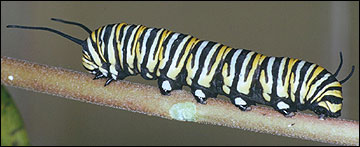Monarch caterpillar
Milkweed butterflies
 Monarch caterpillars (Danaus plexippus) are present in summer months. They produce multiple generations per year.
Monarch caterpillars (Danaus plexippus) are present in summer months. They produce multiple generations per year.
Full-grown caterpillars are two inches long and colored with alternating, transverse white, black and yellow stripes. There is a pair of fleshy tentacles at both the anterior and the posterior ends. The mid-abdominal prolegs are black with lateral patches of white. Body texture is smooth and without hair. Host plants are milkweed species.
About the family
Milkweed butterflies are in the Danaidae family.
Monarch butterfly
 Monarch butterfly caterpillars and other butterflies of the family Danaidae prefer milkweed and are immune to its toxins. Consuming milkweed gives the caterpillars and adults an unpleasant taste, protecting them from predation by birds and parasites.
Monarch butterfly caterpillars and other butterflies of the family Danaidae prefer milkweed and are immune to its toxins. Consuming milkweed gives the caterpillars and adults an unpleasant taste, protecting them from predation by birds and parasites.
The monarch butterfly, Danaus plexippus, is one of 200 species of butterflies found in Missouri. Other common butterflies statewide are the painted lady and the great spangled fritillary plus various skippers, swallowtails and sulphurs.
Monarch butterflies have distinctive orange and black wings with a wingspan of up to 4 inches. They have a pair of forewings and a pair of hindwings, three pairs of legs (though one pair is small and held closely to the front of the body) and compound eyes.
Butterflies love the sun and many of the nectar-producing plants they prefer need full sunlight. Most larvae and caterpillars of butterflies are not considered pests, the exception being the imported cabbageworm.
To attract butterflies to the home landscape, provide a succession of their favorite blooming plants, such as asters, coneflowers, butterfly bushes and other plants with either large petals for the butterflies to rest on, or multiple florets for them to feed from. Plant several of the same plants together to attract butterflies.